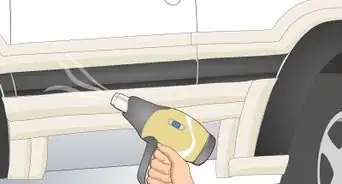This article was co-authored by wikiHow staff writer, Dan Hickey. Dan Hickey is a Writer and Humorist based in Chicago, Illinois. He has published pieces on a variety of online satire sites and has been a member of the wikiHow team since 2022. A former teaching artist at a community music school, Dan enjoys helping people learn new skills they never thought they could master. He graduated with a BM in Clarinet Performance from DePauw University in 2015 and an MM from DePaul University in 2017.
There are 7 references cited in this article, which can be found at the bottom of the page.
This article has been viewed 2,159 times.
Learn more...
Tar is a notoriously sticky substance, and it can be a huge headache when it gets on PVC, other plastics, or even worse, on your car. Thankfully, you have a lot of options when it comes to de-tarring your PVC surface or car plastic without damage. We’ve put together a handy list of ways to remove tar from plastic and cars, from commercial cleaners to household chemicals to natural DIY solutions. If you’re ready to get out of a truly sticky situation, read on!
Things You Should Know
- Apply commercial tar removers or chemical cleaners like Citrol or Goo Gone to tar spots and wipe them clean with a microfiber cloth.
- Try household chemical solvents like WD-40, mineral spirits, or kerosene if you don’t have a commercial cleaner on hand.
- For non-toxic cleaning options that won’t damage surfaces or finishes, try using vegetable oil, mayonnaise, or even peanut butter.
Steps
Warnings
- Avoid using pure petroleum as a solvent. It will remove tar, but will likely destroy any paint jobs or finishes on car bodies or plastic surfaces.[20]⧼thumbs_response⧽
References
- ↑ https://carcarereviews.net/blog/how-to-remove-tar-from-car/
- ↑ https://www.tipsbulletin.com/how-to-remove-tar-from-a-car/
- ↑ https://www.tipsbulletin.com/how-to-remove-tar-from-a-car/
- ↑ https://www.tipsbulletin.com/how-to-remove-tar-from-a-car/
- ↑ https://car.tips.net/T004753_Removing_Tar_from_Your_Car.html
- ↑ https://homesteady.com/13420345/how-to-make-tar-remover
- ↑ https://www.tipsbulletin.com/how-to-remove-tar-from-a-car/
- ↑ https://homesteady.com/13420345/how-to-make-tar-remover
- ↑ https://www.sciencedirect.com/science/article/pii/S0378382015000041
- ↑ https://homesteady.com/13420345/how-to-make-tar-remover
- ↑ https://carcarereviews.net/blog/how-to-remove-tar-from-car/
- ↑ https://homesteady.com/13420345/how-to-make-tar-remover
- ↑ https://homesteady.com/13420345/how-to-make-tar-remover
- ↑ https://carcarereviews.net/blog/how-to-remove-tar-from-car/
- ↑ https://myrooff.com/how-to-remove-roofing-tar-from-metal/
- ↑ https://www.tipsbulletin.com/how-to-remove-tar-from-a-car/
- ↑ https://www.smartmotorist.com/how-to-remove-tar-from-car-with-household-commercial-products
- ↑ https://carcarereviews.net/blog/how-to-remove-tar-from-car/
- ↑ https://carcarereviews.net/blog/how-to-remove-tar-from-car/
- ↑ https://www.smartmotorist.com/how-to-remove-tar-from-car-with-household-commercial-products




































































